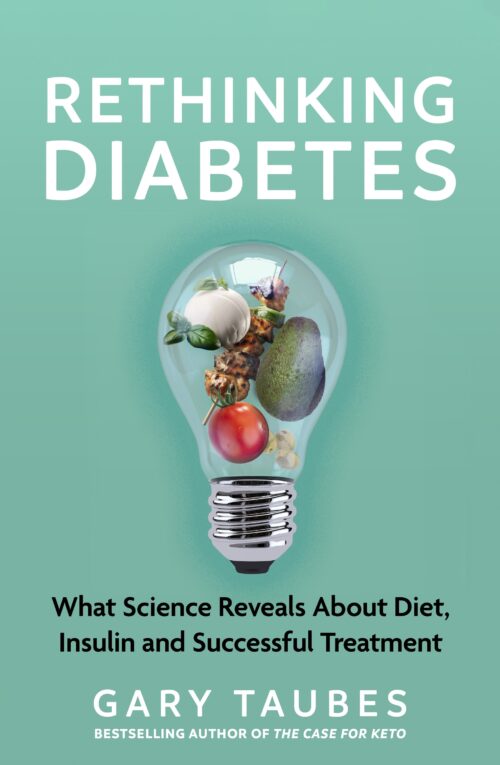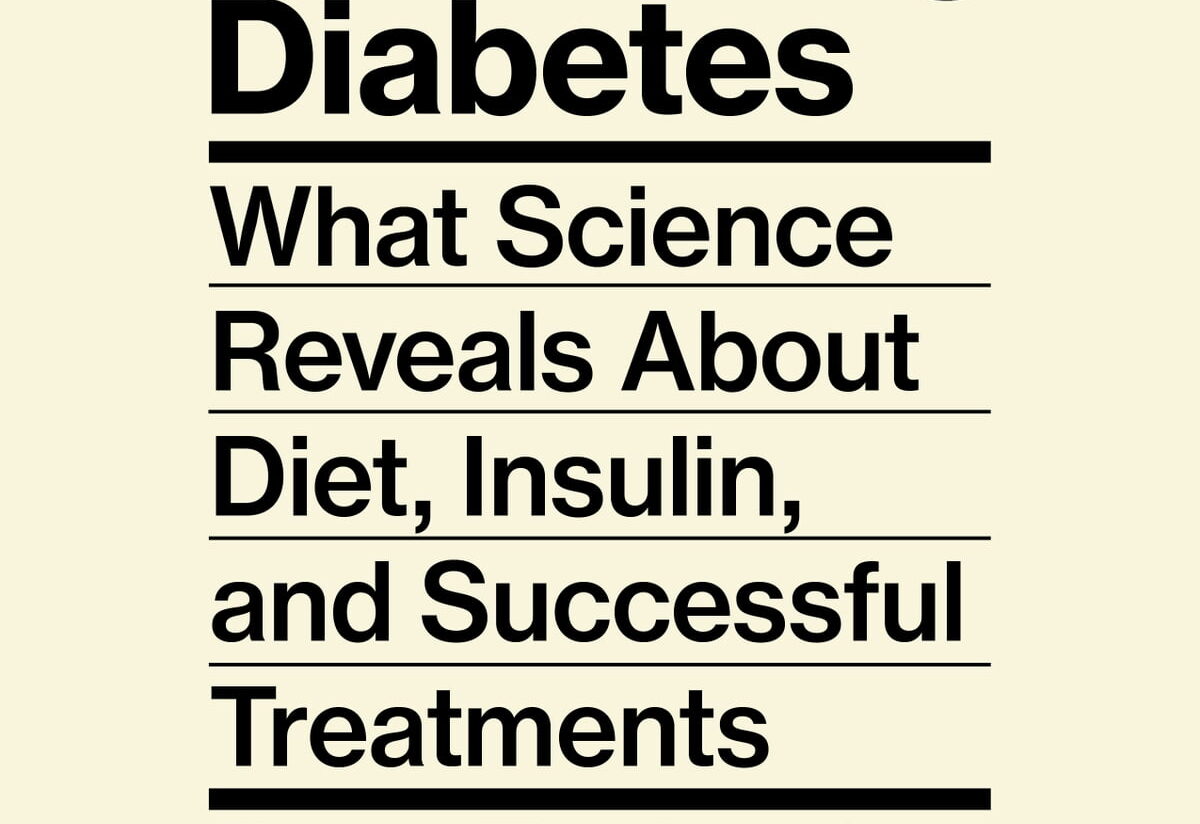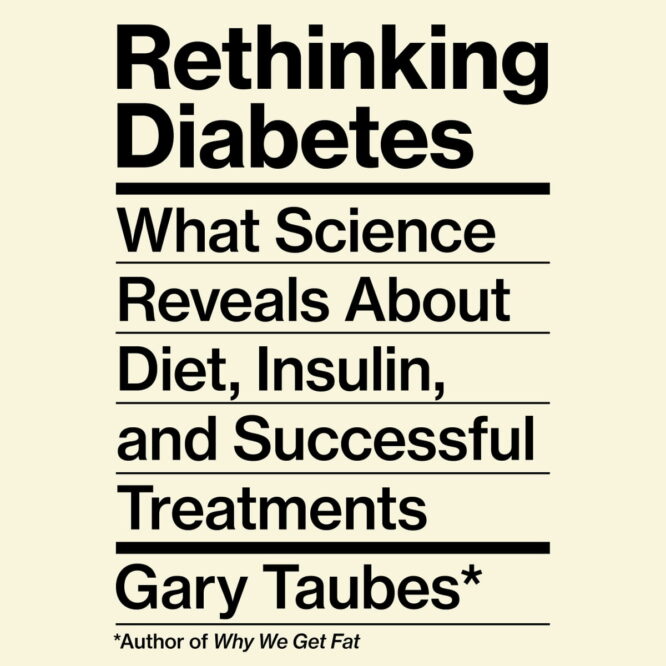
In Gary Taubes1 latest book, “Rethinking Diabetes: What Science Reveals About Diet, Insulin, and Successful Treatments”, Taubes takes a long, hard look at the long history of diabetes, the voluminous research on its treatment, and why, after all these years, he thinks treatment hasn’t been working. In other words he asks and answers the questions, how did we go from diabetes, once a rare disease, to type 1 and type 2 diabetes affecting 38.4 million Americans2? His answer lies in bad science. He argues for more research on diet, particularly lower carbs and more fat, rather than more drugs and more long term side effects.
Taubes, whose previous books “Good Calories, Bad Calories” and “Why We Get Fat”, is a well- known investigative science and health journalist who won the Robert Wood Johnson Foundation Investigator Award in Health Policy Research. It should also be noted that as someone who championed a keto diet to reduce obesity and manage diabetes years before it became acceptable science, he is not without controversy.3
“Rethinking Diabetes” is a massive book, and I do mean massive. Including the bibliography, it nears 500 pages; we are talking Mariana Trench kind of deep dive into research here. Nearly half of it is dedicated to decades of diabetes research. From Culture Desk’s side effect perspective, it was effectively science-backed, and whether one agrees with his low carb fanaticism or not, Tabues makes some compelling arguments. It is an easy argument to follow that eating without any intentional diet and taking a drug to manage diabetes has contributed to an explosion in diabetes. For Taubes, reimagining diabetes requires diet, not drugs, to be moved to the center of the conversation. Talk about changing the conversation of side effects, “Rethinking Diabetes” does exactly this.
It may seem odd to think that diet is not already the center of the conversation. For the past 100 years, diet has been an essential part of diabetes therapy. However, it is only a very specific kind of diet. The American Diabetes Association (ADA) refers to this diet as “medical nutritional therapy” (MNT), and it is something that you go on and off as necessary. Taubes points out that the dietary recommendations of MNT have evolved over the years with little research to back up the changes. While new medications and ways to deliver insulin, lower and monitor blood sugar, are all backed with robust trials. One is left to wonder, as Taubes does, what if there were clinical trials and detailed research on different kinds of diets? And what if these variations in diet were as scientifically studied as the drugs that supersede them?
Rethinking Research
Taube writes a lot of statistics. They further his point, the entire book is research-based after all, but the bombardement with facts and figures is relentless, and I found myself sometimes lost in its barrage. Stil, Taubes also writes compelling human stories to fill in those numbers, and this is what got me through the book.
The numbers could also be stories in and of themselves. One set stood out to me. He writes that in the past 100 years we went from 1 in 300-400 Americans having one of the two types of diabetes, to a breathtaking 1 in 9 Americans. After so much pharmacological success and decades of research, he asks us why we are making the circuitous journey of disease symptoms to drug solution, rather than starting with diet in an effort to prevent or manage the disease in the first place. He is single minded in his persuasiveness when calling for scientific research on all kinds of diets before drugs. Was I convinced? Maybe. It’s hundreds of pages, but for anyone who has type 1 or type 2 diabetes, cares for someone who does, has diabetic patients/clients, this is an essential read. For the rest of us, I’m not so sure.
Rethinking Diet
Why the obsession with rethinking the research in diet? He tells us that in 1971 the American Diabetes Association transitioned from recommending a low carbohydrate diet to prescribing carbohydrate rich and low fat diets for patients with diabetes, since that is what the American Heart Association was prescribing for all Americans, a recommendation irrespective of whether one had diabetes or not.
Taub writes:
“For the first time in history, patients with diabetes were being counseled en masse that as much as 60 percent of all their calories should come from the one macronutrient (carbohydrates) that their bodies could not safely metabolize without pharmaceutical assistance. The evidence did not exist at the time to know whether such a diet lessened the long term complications of the disease or made them worse… The premise of this book, of course, is that they were wrong.”
Taube’s conclusion is that most of the research on diabetes was either bad science, or conducted under the assumption that diabetic therapy should be centered around drugs first. An example of this is when he writes about one of the largest and most influential clinical trials, the United Kingdom Prospective Diabetes Study (UKPDS).4 Starting in 1977 the study enrolled four thousand patients who were newly diagnosed with type 2 diabetes and followed them for 14 years. All of the patients followed ADA guidelines– “low in saturated fat, moderately high fiber… about 50% calories from carbohydrates; overweight patients were advised to reduce energy content.” Following three months of this dietary therapy, they were randomly split into two groups. Half continued to manage the condition using diet alone, the other half participated in drug therapy. They were prescribed oral hypoglycemic agents (OHA)5 such as sulfonylureas, drugs that reduce blood glucose levels by stimulating insulin secretion, an insulin sensitizing agent metformin6, or insulin. As long as they maintained healthy blood sugar levels according to ADA guidelines, they remained in the diet or single drug study, meaning, they still had diabetes, but it was controlled by either the diet or the drug. However, if they could not remain under glycemic control, they were prescribed more drugs or more insulin therapy, and then followed for another nine years.
The first results published in 1998 found that drug therapy alone reduced the risk of microvascular complications compared to diet alone.7 The results, which showed that the drugs reduced the likelihood of microvascular complications common in diabetes, were hailed as a success. The ADA also pointed out that the study suggested the drugs were safe, because they did not raise the risk of heart disease. Taubes, however, writes that this conclusion misses the mark. First, he disagreed that the drugs actually reduced microvascular complications because they still increased the prevalence of hypoglycemic episodes and weight gain. Second, while the ADA pointed out that insulin did not raise the risk of heart disease, Taub points out that the treatment didn’t LOWER the risk either.
And in the end, the study showed that neither the ADA diet nor the drugs stopped the progression of diabetes. In other words, patients’ diabetes disease continued to get worse throughout the study.8 Nine years in, less than one in ten patients on diet alone was still maintaining blood sugar control, and only one in four on the drugs were able to maintain blood sugar control. The researchers concluded that this meant that not only was diabetes a chronic, progressive disease, but that the medications were more effective than diet at controlling it. However, Taubes argues that this, too, was a faulty takeaway, because it assumes diabetes is a chronic progressive disease based on a study of just one type of diet that was never adequately researched to begin with. And to this day, it still requires even more drugs or increasing doses of current drugs to keep diabetes under control.
Who Should Read This Book?
For MedShadow readers, Taubes’ book has some fascinating drug side effect history, research, current rethinking on medicines and their side effects, and the treatment of diabetes. But “Rethinking Diabetes” is not just a history of what he considers bad science, Taubes dips into everything from the demonization of fat9, socio-economic and racial differences in diabetes10, and the future of glucagon-like peptide-1 receptor (GLP-1) agonists such as Wegovy. I am not sure that is enough of a hook to get lost in the hundreds of pages of research, even if the scientific argument is compelling, and the personalized storytelling is engaging. There are far more accessible ways to understand diet and diabetes, including MedShadow’s own Emma Yasinski’s personal story, or even a more digestible interview with Taubes.11 However, if diabetes impacts you personally or professionally, his call to action regarding more research centered around the effects of a low carb/high fat diet on diabetes is thoroughly and convincingly argued. Whether readers come to the same conclusion as Taubes, or have legitimate concerns about his claims, the rigor of research applied to a pharmacological solution to diabetes can only help us if we apply that same rigor in research to diet.12
I am not a healthcare practitioner, nor do I have diabetes. My takeaway after reading this book was that this book was not for me. However, and this is a big however, for the millions of Americans who live with diabetes, “Rethinking Diabetes” is a must-read. Why the difference? The research in this book is formidable, at times overwhelming, and I lacked both the personal and professional experience to judge whether or not I agreed with his takeaways. If you are not a healthcare professional, but someone who lives with diabetes, Taubes’ fluency in science-backed research for the layperson in “Rethinking Diabetes” will resonate with you.
Taubes certainly gives readers more than enough research as food for thought and readers can make up their own minds. But for most readers, including myself, the research was often too technical. There are author interviews with Taubes that are much easier to understand, and what he is saying in Rethinking Diabetes is important to be heard. To reimagine diabetes, for the millions of Americans who live with diabetes and the side effects of the disease and the drug treatments, there is no time to waste.







